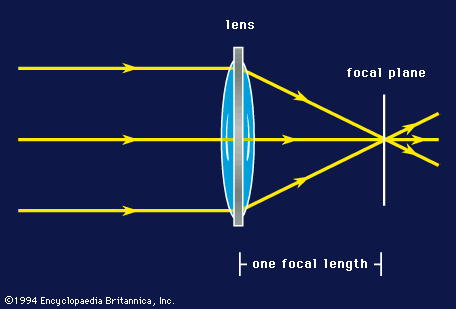
Commonly known as refractors, telescopes of this kind are used to examine the visible-light region of the electromagnetic spectrum. Typical uses include viewing the Moon, other objects of the solar system such as Jupiter and Mars, and double stars. The name refractor is derived from the term refraction, which is the bending of light when it passes from one medium to another of different density--e.g., from air to glass. The glass is referred to as a lens and may have one or more components. The physical shape of the components may be convex, concave, or plane-parallel. Figure 2 illustrates the principle of refraction and the term focal length. The focus is the point, or plane, at which light rays from infinity converge after passing through a lens and traveling a distance of one focal length. In a refractor, the first lens through which light from a celestial object passes is called the objective lens. It should be noted that the light will be inverted at the focal plane. A second lens, referred to as the eyepiece lens, is placed behind the focal plane and enables the observer to view the enlarged, or magnified, image. Thus, the simplest form of refractor consists of an objective and an eyepiece.

The diameter of the objective is referred to as the aperture; it typically ranges from a few centimeters for small spotting telescopes up to one meter for the largest refractor in existence. The objective, as well as the eyepiece, may have several components. Small spotting telescopes may contain an extra lens behind the eyepiece to erect the image so that it does not appear upside-down. When an object is viewed with a refractor, the image may not appear sharply defined, or it may even have a predominant colour in it. Such distortions, or aberrations, are sometimes introduced when the lens is polished into its design shape. The major kind of distortion in a refractor is chromatic aberration, which is the failure of the differently coloured light rays to come to a common focus. Chromatic aberration can be minimized by adding components to the objective. In lens-design technology, the coefficients of expansion of different kinds of glass are carefully matched to minimize the aberrations that result from temperature changes of the telescope at night.
Eyepieces, which are used with both refractors and reflectors, have a wide variety of applications and provide observers with the ability to select the magnification of their instruments. The magnification, sometimes referred to as magnifying power, is determined by dividing the focal length of the objective by the focal length of the eyepiece. For example, if the objective has a focal length of 254 centimeters (100 inches) and the eyepiece has a focal length of 2.54 centimeters (1 inch), then the magnification will be 100. Large magnifications are very useful for observing the Moon and the planets; however, since stars appear as point sources owing to their great distances, magnification provides no additional advantage when viewing them. Another important factor that one must take into consideration when attempting to view at high magnification is the stability of the telescope mounting. Any vibration in the mounting will also be magnified and may severely reduce the quality of the observed image. Thus, great care is usually taken to provide a stable platform for the telescope. This problem should not be associated with that of atmospheric seeing, which may introduce a disturbance to the image due to fluctuating air currents in the path of the light from a celestial or terrestrial object. Generally, most of the seeing disturbance arises in the first 30 meters of air above the telescope. Large telescopes are frequently installed on mountain peaks in order to get above the seeing disturbances.
Excerpt from the Encyclopedia Britannica without permission.